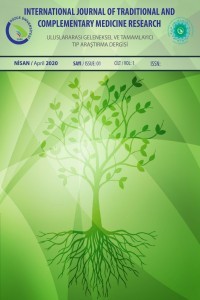
International Journal of Traditional and Complementary Medicine Research
Yazarlar: ["Morufat OLAİTAN", "Blessing NWADİKE"]
Konular:-
DOI:10.53811/ijtcmr.1193807
Anahtar Kelimeler:Antimicrobial Resistance,Multidrug Resistant Microorganisms,ESBL,Antimicrobial Activity,Indigenous Plant,Phytotherapy
Özet: Objective: Majority of the current antibiotics have become less effective due to widespread of multidrug-resistant microorganisms. Medicinal plants are promising candidates that could be used to manage this menace. Therefore, phytochemical, toxicological and antimicrobial potentiality of Lawsonia inermis extracts against MDR clinical bacteria were carried out. Material-Method: Henna leaf and seed were extracted by cold maceration technique using methanol and water and screened phytochemically. Eight MDR isolates, four of which are ESβL-producers were used for this study. In vitro antimicrobial efficacy and quantitative antimicrobial potency of extracts were estimated. MIC and MBC were determined using broth macrodilution technique. Cytotoxicity test was conducted using brine shrimp lethality assay and LC50 was determined. Results: The findings of this study revealed that aqueous leaf extract possesses maximum percentage yield of 25.58%. Tannins and phenolic compounds were detected in all extracts, while steroid was absent. Methanol seed extract showed the highest antimicrobial efficacy against all bacteria with 100 percent activity. The highest and lowest zones of inhibition were recorded at 30.0±0.00 and 10.0±0.00 mm, respectively. The zones of inhibition of extracts differed significantly. All extracts displayed highest activity index against the ESβL-producing Enterobacter aerogenes 196 that was isolated from wound with highest value at 4.28. Pseudomonas aeruginosa U109 showed maximum susceptibility index (93.75%); majority of MIC values recorded were within the range of 1.95-62.5 mg/mL. Cytotoxicity test of methanol and aqueous extracts displayed 1000 1000, respectively. Conclusion: Findings from this study elucidate the efficacy of Lawsonia inermis as a potential remedy to manage MDR-related infectious bacteria.